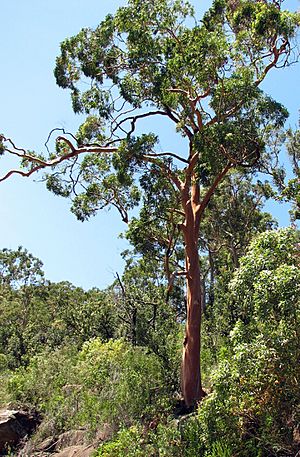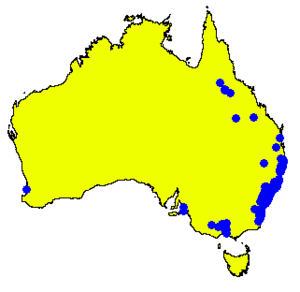Sydney red gum facts for kids
Quick facts for kids Sydney red gum |
|
|---|---|
 |
|
| Angophora costata in Garigal National Park | |
| Scientific classification | |
| Genus: |
Angophora
|
| Species: |
costata
|
 |
|
| Occurrence data from AVH | |
| Synonyms | |
|
Metrosideros costata Gaertn. |
|
The Sydney red gum, also called the smooth-barked apple, is a beautiful tree found only in eastern Australia. Its scientific name is Angophora costata. This tree is known for its smooth bark, long leaves, and pretty white or cream-colored flowers. It also produces ribbed, bell-shaped fruits.
Contents
What Does the Sydney Red Gum Look Like?
The Sydney red gum is a medium to tall tree. It can grow up to 30 meters (about 100 feet) high. It has smooth bark that is usually pink or cream. This bark changes to grey over time and peels off in small pieces. It's the only Angophora tree with smooth bark on its main trunk.
Leaves and Flowers
Young Sydney red gum trees have oval-shaped leaves that grow directly from the stem. These leaves are about 6 to 12.5 cm long. Adult trees have glossy green leaves that are lance-shaped. They are usually 7 to 19 cm long. These leaves grow in pairs opposite each other on the branches.
The flowers grow in groups, usually three buds together. The buds are oval or globe-shaped. The flowers themselves are white or creamy white. You can see them blooming from October to December.
Fruit
After flowering, the tree produces oval or bell-shaped fruits. These fruits are like capsules and can be up to 2 cm long and wide. They have distinct ribs on their surface.
Where Does the Sydney Red Gum Grow?
The Sydney red gum naturally grows in the sandy soils of Queensland and New South Wales in Australia. It's very common in south-eastern Queensland. In New South Wales, you'll find it along the coast, from Coffs Harbour down to Narooma. It also grows as far west as the Blue Mountains.
Habitat and Friends
In the Sydney area, these trees live in open forests and woodlands. They often grow alongside other native Australian trees. These include the Sydney peppermint, bangalay, turpentine, and forest oak. They also grow in sand dune areas with plants like wedding bush and burrawang.
Life Cycle and Ecology
Sydney red gum trees can live for over 100 years! They are very tough, especially when it comes to bushfires. If there's a fire, new shoots can grow back from the branches and trunk within a month. Young plants can also sprout new growth from their base. New seedlings often appear within 9 to 10 months after a fire.
Animals and the Sydney Red Gum
This tree is an important part of its ecosystem. Some animals rely on it for food or shelter.
- A type of mistletoe, called the long-flowered mistletoe, can grow on the Sydney red gum.
- Grey-headed flying foxes and little red flying foxes eat the flowers.
- The seeds are a favorite food for the crimson rosella, a colorful parrot.
Growing Sydney Red Gums
The smooth-barked apple is a popular tree to plant in gardens and parks. It can grow well in many different places. You can easily grow new trees from seeds. Just make sure the soil is loose and drains well.
Some Sydney red gums grow straight and tall. Others have more twisted branches, which gives them a unique look. It's good to know that these trees sometimes drop branches. So, it's best not to plant them too close to buildings.
Famous Sydney Red Gums
There have been some very old and large Sydney red gum trees.
- Angophora Reserve in Avalon, Sydney, was named after a giant tree. This tree was thought to be about 300 years old, but it died in the late 20th century.
- In the upper Lane Cove River Valley in Sydney, there are several large Sydney red gums. One tree near Conscript Pass was measured at 45 meters (about 148 feet) tall!
- The biggest known living Sydney red gum in New Zealand is in Hobsonville, near Auckland. Its trunk is 241 cm (almost 8 feet) across!
Gallery
- Features of the Angophora costata
See also
 In Spanish: Angophora costata para niños
In Spanish: Angophora costata para niños








